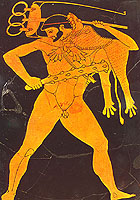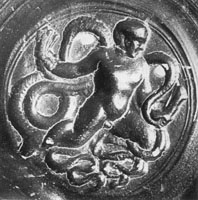Herakles (Roman Hercules)



Most popular of the Greek heroes; son of
Zeus and Alkmene, a Greek princess of Thebes, whom
Zeus seduced by pretending to be her husband Amphitryon. He proved his courage before he was even one year old, by strangling two snakes sent by
Hera to kill him. He went on to accomplish Twelve Labours, imposed by
Hera and performed in the service of
Eurystheus, King of
Argos, and to survive several other adventures (see under
Acheloos, Alkestis,
Alkyoneus,
Antaios,
Busiris,
Chiron,
Eurytos,
Geras,
Hebe,
Hesione,
Kerkopes,
Linos,
Philoktetes,
Pholos (Centauromachy),
Theseus,
Triton). He led an army against the
Amazons, in the course of which he also attacked and sacked
Troy. Sometimes he attacked gods -
Apollo for his
tripod, and
Poseidon. His companion was his nephew
Iolaos. He served as a divine role model for humanity, succeeding through strength and courage, not magic; but he was regularly supported by
Athena, and is shown with her so often in archaic Athenian sculpture and vase painting, that it seems that the pair symbolized the fortunes of
Athens, later to be a role for
Theseus. He eventually won admission to
Olympos as a god and may be shown being introduced there, on foot or by chariot, but from the 5th century on this results from his self-immolation on a funeral pyre on Mount Oita. He wore the skin of the
Nemean Lion (from his First
Labour) and carried a club and bow; his cup is the kantharos.
The sculptural type devised by
Lysippus in the 4th century determined most later representations of Herakles (exemplified in the right hand image above).
Above left: Detail from an Athenian red-figure clay vase, about 480 BC. Würzburg University, Martin von Wagner Museum 500. © Martin von Wagner Museum
Above middle: Guttus, Apulian. Würzburg University. Martin von Wagner Museum H.5170. Photo. Mus. KB 128/12 © Martin von Wagner Museum
Above right: Colossal marble statue. Naples. Museo Archeologico Nazionale 6001. Photo. Anderson 26605. © Museo Archeologico Nazionale, Naples


